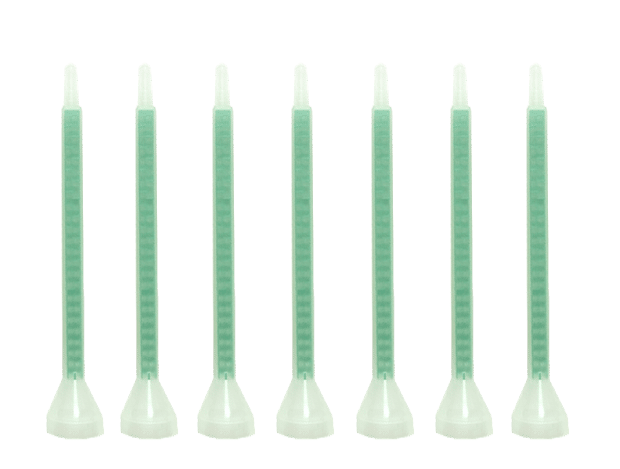In the world of adhesives, sealants, and various other industrial applications, achieving a thorough and consistent mixture is crucial. One of the key tools in this process is the mixing nozzle. The mixing nozzles are usually categorized into static mixing nozzles and dynamic mixing nozzles, but we probably see epoxy mixing nozzles most often. So there is often a question that arises: Do epoxy mixing nozzles belong to static mixing nozzles? In this blog, we’ll explore this question and introduce you to various types of static mixing nozzles.

Are Epoxy Mixing Nozzles belong to Static Mixing Nozzles?
Yes, epoxy mixing nozzles belong to the category of static mixing nozzles. They rely on the same fundamental principle of static mixing to achieve proper blending of epoxy resin and hardener. By creating turbulent flow and dividing the material streams into multiple layers, epoxy mixing nozzles ensure that the two components are thoroughly mixed as they exit the nozzle. So, if you’re using epoxy mixing nozzles, you are indeed using a type of static mixing nozzle.
Why Epoxy Needs Mixing Nozzles?
Epoxy adhesives require mixing nozzles to blend epoxy resin and hardener accurately. These nozzles maintain the precise mixing ratio crucial for proper curing. They ensure a uniform, homogenous mixture, preventing incomplete blending that might weaken adhesive bonds or lead to uneven curing. Mixing nozzles also minimize the introduction of air bubbles, which can compromise bond strength. By facilitating efficient mixing, they contribute to the overall reliability of epoxy adhesive bonds. Furthermore, they reduce waste by enabling the mixing of only the required amount of epoxy, making them indispensable tools in industries where precise and reliable bonding is essential, such as construction, automotive, and aerospace.
Other Types of Static Mixing Nozzles
While epoxy mixing nozzles are one common example of static mixing nozzles, there are several other types designed for various applications:
-
Helical Mixing Nozzles:
These feature helical mixing elements that twist the material streams together as they pass through the nozzle, ensuring even mixing.
-
Rectangular Mixing Nozzles:
These have a rectangular geometry with multiple channels and mixing elements to achieve effective blending.
-
Bell Mixers:
Bell mixers have a bell-shaped design and are often used in the food and pharmaceutical industries for mixing viscous substances.
-
Tubular Mixers:
Tubular static mixers consist of multiple cylindrical elements aligned in a row, providing a simple and cost-effective solution for mixing.
-
High-Pressure Mixing Nozzles:
These nozzles are built to withstand high pressures and are used in applications where the material needs to be mixed under extreme conditions.
Conclusion
In summary, epoxy mixing nozzles are indeed a type of static mixing nozzle. Static mixing nozzles, including epoxy mixing nozzles, offer an efficient and reliable way to blend two or more components of a material without the need for mechanical agitation.
However, for higher viscosity adhesives, dynamic mixing nozzles are always the best choice!
